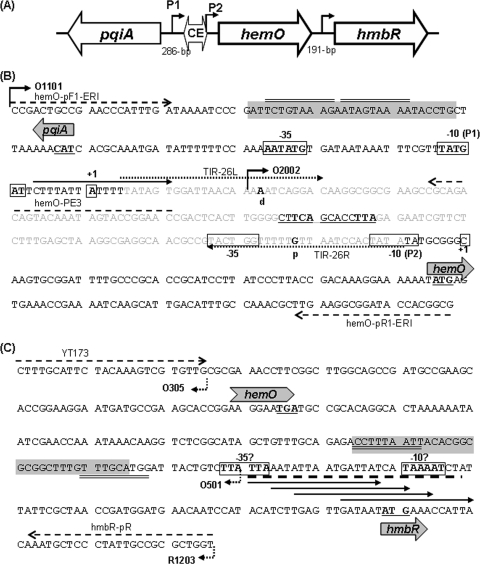FIG. 2.
(A) Organization of the hemO-hmbR locus in meningococcal strain NMB. The hemO gene is transcribed divergently from the pqiA (hmp) gene with a 286-bp intergenic space that includes a full-length Correia element (CE) (6), while hemO is separated from hmbR by a 191-bp intergenic region. The bent arrows represent the promoters of hemO and hmbR. The schematic diagram is not to scale. (B) Sequence of the 5′ region of hemO. The ATG start codons are in bold type and underlined, and the large arrows show the direction of transcription. The sequence of the CE is in gray type, the terminal inverted repeats (TIR) are indicated by dotted arrows, and the IHF binding sequence in the CE is underlined, with the nucleotides matching the consensus sequence nucleotides (7) in bold type. The putative transcript processing sites in the TIRs are indicated by bold type and labeled d and p. The putative Fur binding motif matching the (NATWAT)3 motif is indicated by an arrow. The sequence protected by MisR in the DNase I protection assay is in bold type and shaded, and the sequences matching the MisR binding motif are indicated by double overlining. The 5′ ends of two hemO::lacZ fusions are indicated by bent arrows, and the hemO-pR1-ERI primer is the corresponding 3′ end. The hemO-pF1-ERI primer used to generate probes for DNase I protection assay and the hemO-PE3 primer used in primer extension are indicated by dashed arrows. The two transcriptional start sites and the two corresponding promoter elements are enclosed in boxes. (C) Nucleotide sequence of the hmbR promoter region. The stop codon of hemO and the start codon of hmbR are in bold type and underlined. The putative −10 and −35 hexamers are in bold type and enclosed in boxes. The sequence protected by MisR is shaded, and the two matching MisR consensus motifs are indicated by double underlining. The Fur-protected sequence reported by Delany et al. (10) is indicated by a dashed line. The primers used for the EMSA and DNase I protection assay, YT173 and hmbR-pR, are indicated by dashed arrows. The dotted bent arrows indicate the 3′ ends of promoter fragments cloned in reporter strains O305, O501, and R1203.

